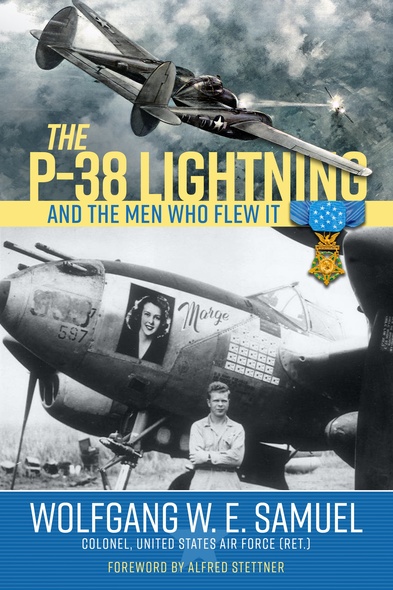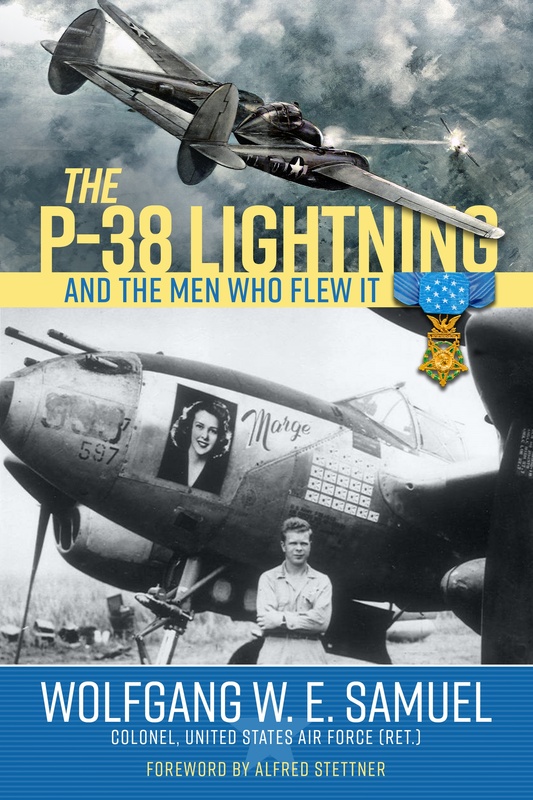
The P-38 Lightning and the Men Who Flew It
The P-38 Lightning was one of the fastest operational fighters of World War II, famous for its successes in North Africa and the Pacific. In The P-38 Lightning and the Men Who Flew It, Wolfgang W. E. Samuel shares the stories of the young men who climbed into the cockpits of the P-38 to fight for freedom, and of those who created, tested, and deployed these fearsome machines.
The P-38 was the product of the Lockheed Corporation, the first fighter they ever built, principally conceptualized by Kelly Johnson, whose design was to meet Air Corps specifications. To do that he came up with a twin-engine aircraft with a tricycle landing gear unlike any other military aircraft of the time. But it was no easy plane to fly. Many pilots died in training and routine flying before ever meeting an opponent in combat.
P-38 units were formed quickly once the United States entered World War II in December 1941. Training was rushed to get pilots and planes to Europe as quickly as possible to serve as bomber escorts. Although the P-38 could fly at the high altitudes the bombers flew, it was not the right aircraft for the mission. At high altitudes without an engine in front of the cockpit to keep the pilot warm, the plane was frigid. Pilots suffered and were sometimes so weakened by the brutal cold that they had to be lifted out of the cockpit upon landing, and the bombers suffered severe losses. In North Africa’s warmer air, however, the P-38 came into its own. With four 50-caliber machine guns and a 20mm cannon in its nose, the P-38 was a formidable adversary. With proven success in the Mediterranean, P-38 squadrons were transferred to the Pacific Theater, where they flourished.
This book focuses on the men who flew this challenging aircraft and the men who designed and decided how to deploy it. Samuel shares stories of bravery and ingenuity alongside an aviation history long neglected. The P-38’s Pacific deployment is covered in some detail, including the actions of Richard Bong, who became the US forces’ ace of aces while flying a P-38. In the Pacific skies, the P-38, its pilots, and designers made the heroic history captured here.
In 1943, Lockheed’s P-38Lightninghelped the US Army Air Forces seize control of the air in the Southwest Pacific, and more than a hundred Lightning pilots became aces in the theater. In Europe, theLightning struggled against technical faults and the Luftwaffe but offered long range, accurate gunnery, and twin-engine survivability. Strap into the P-38’s cockpit with Wolf Samuel’s deeply researched account, and you’ll gain admiration and appreciation for those American heroes who mastered this innovative fighter.
Wolfgang Samuel’s latest book is a wonderful read. By allowing the men who flew the P-38 Lightning to tell their tales in their own words, Samuel brings their incredible experiences to life. It ought to be on the bookshelf of everyone interested in the human aspect of aviation and the air war of World War II.
Each interview, rich in detail, brings to life the sacrifices of war. Even statistics regarding the number of training deaths are startling, yet those losses, too, speak to the costs of preparing for battle. The account of Lieutenant Walter Langdon seems particularly striking—he played a relaxed game of Pinochle in the morning but died in a ‘crash and burn’ exchange with the enemy that afternoon. The gift of The P-38 Lightning and the Men Who Flew It is in bringing into bold focus the personal stories of these young pilots who trained to fly these planes during extraordinarily perilous times.
Lockheed’s twin-engine P-38Lightning fighter numbered among the first military planes in World War II to feature tricycle landing gear, which allowed its pilot to see where he was going while taxiing on a runway, unlike tail draggers whose pilots had to taxi side-to-side. Moreover, with the cockpit mounted between the engines, the P-38’s weapons were found only in the cockpit’s nose, which meant they fired straight ahead, unlike single-engine taildraggers whose weapons appeared on each wing and had to be aimed so that the ammunition came together against an enemy at a specified distance. Wolf Samuel’s The P-38 Lightning and the Men Who Flew It covers the P-38 throughout its military existence, along with significant accounts of the aircraft in action by the fighter pilots who flew it. If you wish to know and understand this aerial novelty, you will want to read this book.
Wolfgang W. E. Samuel, Colonel, US Air Force (Ret.), was born in Germany in 1935 and immigrated to the United States in 1951 at age sixteen with an eighth-grade education and no English-language skills. Upon graduation from the University of Colorado, he was commissioned 2nd Lieutenant in the US Air Force and then flew over one hundred strategic reconnaissance missions against the Soviet Union during the Cold War. His first book German Boy: A Refugee’s Story garnered favorable reviews from the New York Times and numerous other outlets. He is author of eight books published by University Press of Mississippi.




